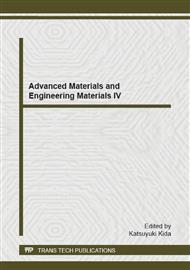[1]
Rønning T.F. Freeze-Thaw Resistance of Concrete. Effect of Curing Conditions, Norway (2001).
Google Scholar
[2]
Davie C.T., Pearce C.J., Bićanić N. Effects of Fluid Transport on the Structural Integrity of Concrete Nuclear Pressure Vessels (2005) Proceeding of the 13 ACME conference: University of Sheffield, Great Britain.
Google Scholar
[3]
Gorchakov G.I., Kapkin M.M., Skramtaev B.G. (1965) Povyshenie morozostojkosti betona v konstrukcijah promyshlennyh i gidrotehnicheskih sooruzhenij, Russia.
Google Scholar
[4]
Kurilko A.S., Novopashin M. D. Features of Low Temperature Effect upon Strength of Enclosing Rock and Kimberlite in the Udachnaya, Pipe (2005) Journal of Mining Science, Vol. 41, No. 2, pp.119-122, Russia.
DOI: 10.1007/s10913-005-0071-7
Google Scholar
[5]
Cherepanov V. I, Nekrasova E. V, Chernyh N. A, Panchenko Ju.F. Vodostojkost' silikatnogo kirpicha (2013) Construction Materials, (9), pp.10-12.
Google Scholar
[6]
Shashank B. Strain variations in concrete subjected to cyclic freezing and thawing (2004) Thesis Submitted to University of Tokyo Department of Civil Engineering, Tokyo.
Google Scholar
[7]
Shanshan J., Jinxi Z., Baoshan H. Fractal analysis of effect of air void on freeze–thaw resistance of concrete (2013) Construction and Building Materials, (47), p.126–130.
DOI: 10.1016/j.conbuildmat.2013.04.040
Google Scholar
[8]
Nesvetaev G.V., Kardumjan G.S. Prochnost' cementnogo kamnja s superplastifikatorami i organomineral'nymi modifikatorami s uchetom ego sobstvennyh deformacij pri tverdenii (2013) Beton i zhelezobeton, (5), pp.6-8.
Google Scholar
[9]
Bunke N. Prüfung von Beton – Empfehlungen und Hinweise als Ergänzung zu DIN 1048 (1991) Schriftenreihe des Deutschen Ausschusses für Stahlbeton, , (422), pp.12-15.
Google Scholar
[10]
Gribniak V., Kaklauskas G., Bacinskas D., Idnurm S. Finite element mesh size effect on deformation predictions of reinforced concrete bridge girder (2000) The Baltic Journal Of Road And Bridge Engineering, 5(1), pp.149-154.
DOI: 10.3846/bjrbe.2010.03
Google Scholar
[11]
Benin, A.V., Semenov, A.S., Semenov, S.G. Fracture analysis of reinforced concrete bridge structures with account of concrete cracking under steel corrosion (2014) Advanced Materials Research, 831, pp.364-369.
DOI: 10.4028/www.scientific.net/amr.831.364
Google Scholar
[12]
Swedish Standard Concrete testing – Hardened Concrete-Frost Resistance, SS 137244, Sweden (2005).
Google Scholar
[13]
RILEM Technical Committee TDC, CDF Test, Test Method for the Freeze-Thaw-Resistance of concrete with sodium chloride solution, RILEM TC 117-FDC Recommendation, Germany (1996).
DOI: 10.1007/bf02485951
Google Scholar
[14]
RILEM Technical Committee CIF Test, Test Method of frost resistance of concrete, RILEM TC 176 Recommendation, Germany (2004).
DOI: 10.1617/14143
Google Scholar
[15]
Gehlen C. Compilation of Test Methods to Determine Durability of concrete (2011) Critical review RILEM Technical Committee TDC, Germany.
Google Scholar
[16]
M. Kosior-kazberuk: Variation in fracture energy of concrete subjected to cycling freezing and thawing (2013)Arhives of civil and mechanical engineering, 13(2), pp.254-259.
DOI: 10.1016/j.acme.2013.01.002
Google Scholar
[17]
Interstate Council for Standardization, Metrology and Certification, GOST 10060-95, Concretes. Russia, (1995).
Google Scholar
[18]
Toturbiev A.B., Cherkashin V.I., Macapulin V.U., Toturbiev B.D. Zharostojkij beton na mestnom prirodnom nanodispersnom kremnezemistom syr'e (2013) Beton i Zhelezobeton, (6), pp.2-5.
Google Scholar
[19]
Kiski S.S., Ageev I.V., Ponomarev A.N., Kozeev A.A., Judovich M.E. Issledovanie vozmozhnosti modifikacii karbosilatnyh plastifikatorov v sostave modificirovannyh melkozernistyh betonnyh smesej (2012) Magazine of Civil Engineering, 34(8) pp.42-46.
Google Scholar
[20]
Ponomarev A.N. Nanoconcrete -concept and prospects. Synergism of nanostructuring cement binders and reinforcing fibre (2007) Construction and Building Materials, 5(5).
Google Scholar
[21]
Kljuev S.V. High-strength fiber concrete for industrial and civil construction (2012) Magazine of Civil Engineering, 34(8), pp.61-66.
DOI: 10.5862/mce.34.9
Google Scholar
[22]
Ponomarev A.N. Vysokokachestvennye betony. Analiz vozmozhnosteĭ i praktika ispol'zovanija metodov nanotehnologii (2009) Magazine of Civil Engineering, 8(6), pp.25-33.
Google Scholar
[23]
Barabanshchikov Yu.G., Semenov K.V. Increasing the plasticity of concrete mixes in hydrotechnical construction (2007) Power technology and engineering, 41 (4), pp.197-200.
DOI: 10.1007/s10749-007-0038-8
Google Scholar
[24]
Kalashnikov V.I., Tarakanov O.V., Kusnetsov Y.S., Volodin V.M., Belyakova E.A. Next generation concrete on the basis of fine-grained dry powder mixes (2012) Magazine of Civil Engineering, 34(8), pp.47-53.
DOI: 10.5862/mce.34.7
Google Scholar
[25]
Gokce А., Nagataki С., Saeki Т., Hisada М. Identification of frost-susceptible recycled concrete aggregates for durability of concrete (2010) Construction and building materials, 25(5), pp.2426-2431.
DOI: 10.1016/j.conbuildmat.2010.11.054
Google Scholar
[26]
Serdjuks D., Rocens K., Pakrastinsh L. Utilization of composite materials in saddle-shaped cable roofs (2000) Mechanikcs of composite materials, 36(5), pp.385-388.
DOI: 10.1023/b:mocm.0000047234.72813.2e
Google Scholar
[27]
Dikun A.D. at al. Opyt jekspressnogo opredelenija morozostojkosti betona transportnyh sooruzhenij, (2005) Construction Materials, (8), pp.55-56.
Google Scholar
[28]
Dikun A.D. at al. Razvitie otechestvennogo dilatometricheskogo metoda prognozirovanija svojstv betona, (2004) Construction Materials, (4), pp.52-56.
Google Scholar
[29]
Dikun A.D. at al. Prognozirovanie morozostojkosti betona, (2003) Construction Materials, (11), pp.28-30.
Google Scholar
[30]
Nikolskiy S.G. and other (2008) RU Patent 2, 380, 681.
Google Scholar
[31]
Nikolskiy S.G. and other (2007) RU Patent 2, 305, 281.
Google Scholar


